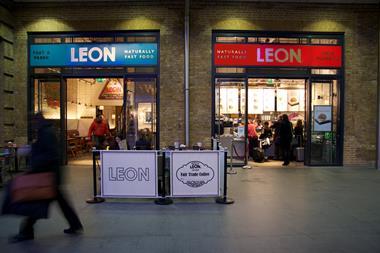Chocolate confectionery continued to see growth this year with a rise of 2.8% to break through the £2.5bn barrier. Shining stars were the variety packs which saw a value increase of 17% to £36m, with assortments also showing good growth at 7.8% (£506m).
Filled bars represent the largest sector, accounting for more than £1bn sales and 44% of all chocolate. Some of this year's 2% growth has been accounted for by the introduction of Cadbury's Fuse. This was a product that took many years to evolve. It was code-named Hobbyhorse because it was the brainchild of one person who just would not give up on the concept, despite the trends which seemed to indicate there wasn't an appropriate gap in the market. The waiting is now paying off for that person's conviction. Sales in November 1996 were almost £10m and 12 months on had exceeded £43m.
Twix, also falling within filled bars, saw growth of 12% fuelled by its relaunch, promotional activity and TV advertising.
Nestlé's KitKat continued its leadership battle, but all three leading brands (which also included the Mars Bar and Cadbury's Dairy Milk) saw sales losses between 2% and 4%).
This development, at a time when the total market was in growth, is believed to have come about because of the new product developments and promotional activity within the fixture. New lines have included Cadbury's Astros, Nestle's Giant Smarties and Maverick, and of course Cadbury's Fuse. Kingsize variants of existing brands such as the Mars Bar have been introduced, together with special editions of Cadbury's Time Out, Caramel and Crunchie, as well as KitKat.
Assortments have seen 7% growth this year, fuelled by launches such as Mars Celebrations and Galaxy Caramel Swirls which have contributed more than £20m to the category since their launch.
Unusually in today's climate, diet chocolate products have seen a 48% sales decline, but the entry of Mars to this category with Flyte and Mars Light selling £12m of product during the year is expected to turn the situation around.
Sugar confectionery rose 10% year on year to £602m. Mints account for 30% of all sugar products, but the main growth is coming from boiled and hard sweets, and chewy sweets.
Boosters for the boiled category have come from the launch of Polo Tangy Fruits and Needlers Barley Sugar Drops. Chews were fuelled by new flavour variants of Chewits which saw its sales rising by 11%.
The usually stable liquorice allsorts sector was given a boost by the introduction of Bassett's Red Allsorts. Diet sugar confectionery suffered the most, despite a lot of npd activity in recent years. It dropped 65% this year to £1m. It will be interesting to see if the major brands will see possibilities in the years to come following Mars initial success in low fat chocolate confectionery. But this could be more dependent on technical developments rather than changing approaches in marketing.
One sugar free area that has seen growth, however, has been within mints, possibly because this is the most popular sector of the sugar confectionery market. Mints account for almost £170m of sales annually, with Polo being the largest brand at £41m and rising 2.4% year on year.{{FEATURES }}
Close menu
- Home
- Retail & Wholesale
-
Products & Suppliers
- Back to parent navigation item
- Products & Suppliers
-
Product Categories:
- Back to parent navigation item
- Product Categories:
- Alcoholic drinks
- Bakery
- Cereals & breakfast
- Cheese
- Chicken & poultry
- Chocolate
- Confectionery
- Crisps, nuts & snacks
- Dairy
- Fish
- Fresh produce
- Frozen
- Household
- Meat
- Own Label
- Sauces & condiments
- Seasonal
- Soft drinks
- Vaping
- Vegan & plant-based
- World foods
- Suppliers
- People
- Reports & Data
-
Topics A-Z
- Back to parent navigation item
- Topics A-Z
-
Popular topics:
- Back to parent navigation item
- Popular topics:
- Cost of living crisis
- Crime
- Deposit Return Schemes
- Finance
- Government & Regulation
- Health
- Inflation
- Loyalty
- Marketing
- Mergers & Acquisitions
- New Product Development
- Sourcing
- Supply chain
- Sustainability & environment
- Technology
- Ultra Processed Foods
- Vaping
- A-Z all topics
- Content by type:
- Events
- Ask iA (beta)
- Subscribe now
Sign in to comment on this article
Not logged in before? Register for FREE guest access today.
You will be able to:
- Read more stories
- Receive daily newsletters
- Comment on stories
Advert
















No comments yet